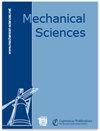改进土木工程结构减振的自适应滑模控制
IF 1.5
4区 工程技术
Q4 ENGINEERING, MECHANICAL
引用次数: 0
摘要
摘要使用磁流变阻尼器的地震振动控制是一项引起世界各地研究人员兴趣的技术。这项技术提供了合适的结构建筑保护,确保了人类安全免受地震激励的破坏。这些设备的鲁棒性在许多情况下取决于设计的控制律。多年来,研究重点是开发和建模各种控制器,以增强建筑物的结构振动消除。本文的重点是评估半主动控制的鲁棒性,以减少三层测试结构的位移。半主动控制装置是安装在地震激励结构底层的磁流变流体阻尼器,由自适应非线性控制器控制,该控制器与削波优化算法耦合以驱动电流。所提出的控制器是一种通过自适应技术增强的滑模控制器,以执行控制增益选择并克服抖振问题。目前的适应定律是两个定律之间的切换条件定律,根据系统状态提供所需的增益。数值模拟结果证明了所提出的半主动控制策略在衰减受试结构位移方面的有效性。本文章由计算机程序翻译,如有差异,请以英文原文为准。
Adaptive sliding-mode control for improved vibration mitigation in civil engineering structures
Abstract. Seismic vibration control using a magneto-rheological damper is a technique that interests several researchers around the world. This technique offers suitable structural building protection, ensuring human safety against earthquake excitation damages. The robustness of these devices depended in many cases on the designed law of control. Over the years, research focused on the development and modelling of various controllers to enhance the structural vibration elimination of buildings. The emphasis of this paper is on the evaluation of semi-active control robustness to reduce the displacements of a three-storey tested structure. The semi-active control device is a magneto-rheological fluid damper installed on the ground floor of the earthquake's excited structure and is controlled by an adaptive non-linear controller coupled to a clipped optimal algorithm to drive the current. The proposed controller is a sliding-mode controller reinforced by an adaptive technique to perform the control gain choice and overcome the chattering problem. The present law of adaptation is a switching conditional law between two laws offering the required gain depending on the system state. The numerical simulation results prove the effectiveness of the proposed semi-active control strategy in attenuating the displacements of the tested structure.
求助全文
通过发布文献求助,成功后即可免费获取论文全文。
去求助
来源期刊

Mechanical Sciences
ENGINEERING, MECHANICAL-
CiteScore
2.20
自引率
7.10%
发文量
74
审稿时长
29 weeks
期刊介绍:
The journal Mechanical Sciences (MS) is an international forum for the dissemination of original contributions in the field of theoretical and applied mechanics. Its main ambition is to provide a platform for young researchers to build up a portfolio of high-quality peer-reviewed journal articles. To this end we employ an open-access publication model with moderate page charges, aiming for fast publication and great citation opportunities. A large board of reputable editors makes this possible. The journal will also publish special issues dealing with the current state of the art and future research directions in mechanical sciences. While in-depth research articles are preferred, review articles and short communications will also be considered. We intend and believe to provide a means of publication which complements established journals in the field.
 求助内容:
求助内容: 应助结果提醒方式:
应助结果提醒方式:


